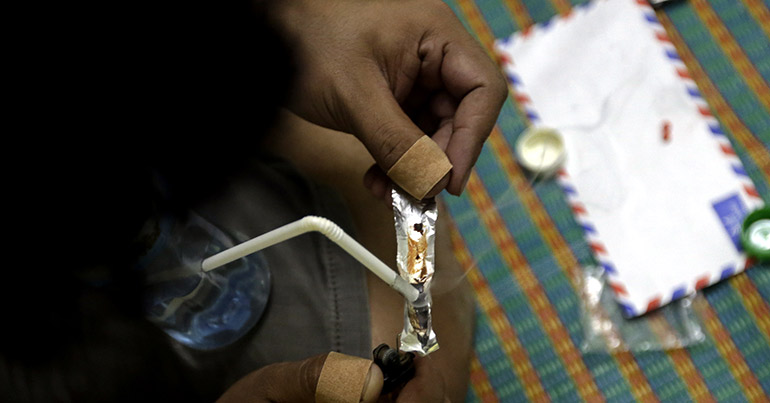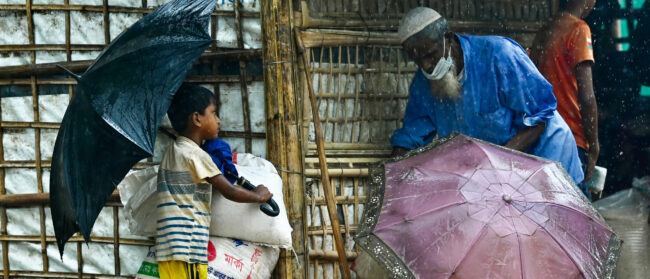The Special Naval School in Chonburi province is located inside an old prison on the Royal Thai Navy’s largest base. It has armed guards and high brick walls topped with barbed wire. ‘We will quit drugs to honour the King’ reads a sign over its forbidding main entrance.
But not even Bhumibol Adulyadej, Lord of Life, Ninth Monarch of the Chakri Dynasty, can help you in here.
Welcome to the Alcatraz of Addiction. Thai men who are arrested for taking drugs are usually sent to military-style boot camps for three months of rehabilitation. Fail the program, or get arrested again, and you could end up at the Special Naval School, where only the most obstinate drug users are sent.
It is home to about 160 men in their twenties and thirties. New arrivals are locked in a cell decorated with pictures of Buddha. They have shaven heads and lots of tattoos, and spend their days beneath a tropical sun, performing exercises and military drills. Anyone who tries to escape is slapped in medieval-looking leg irons.
Most of the men are here because of one drug: methamphetamine. Its pills are known in Thailand as yaba (‘crazy medicine’) and in Khmer as yama (‘horse medicine’), while the purer, crystalline form is known across Asia by street names such as ice, shabu and speed. It is now the first-choice drug in Southeast Asia, China, Taiwan and Japan, according to the United Nations Office on Drugs and Crime (UNODC).
You can buy it in villages in northern Laos, slums in Bangkok and nightclubs in Guangzhou, Jakarta and Phnom Penh. Meth is Asia’s favourite high.
It can be eaten, smoked, snorted or injected. It boosts energy, self-esteem and sexual pleasure. You can work all day and party all night. You can dance for days or stay home and do a thorough spring clean.
Ice can cause obsessive or repetitive behaviour, as Andre Agassi discovered when he snorted it in 1997. “I’ve never felt such energy,” he wrote later. “I’m seized by a desperate desire to clean. I go tearing around my house, cleaning it from top to bottom. I dust the furniture. I scour the tub. I make the beds.” The next year, Agassi won the French Open.
Meth gets you high, and meth screws you up. Withdrawal symptoms include fatigue, anxiety, paranoia, aggression and depression. If you can spot the line between recreational use and addiction, you’ve probably already crossed it.
“It made me paranoid,” says Wulan, 34, a former addict who now runs Stigma, an Indonesian foundation to decriminalise drug users. “I heard voices,” he adds. Your appetite vanishes. You stop sleeping. You want more.
The euphoria users feel is a brain-rush of a neurotransmitter called dopamine. Meth use overstimulates and desensitises your dopamine receptors, so you soon need more of the drug to feel the same buzz. Heavy users can take months or even years to recover. And all the while, your brain craves dopamine to make it feel good again.
The rise and rise of methamphetamine baffles and terrifies Asian governments. The drug is ubiquitous. Its popularity bestrides social and economic divides, town and country, work and leisure. Asia’s incredible economic growth has created a huge middle class with cash to burn – a whole new generation of recreational drug users.
A Rehab Generation has been created, too. Meth addiction is hard to treat. You can’t sweat it out. There is no methadone-like substitute. The only effective treatment is voluntary counselling, but that takes time and money, and is complicated by meth’s widespread appeal. How do you design psychotherapy to successfully rehabilitate not just Thai tattoo artists, but also Laotian farmers, Chinese stockbrokers, Filipino clubbers, Cambodian sex workers and Indonesian rock stars?
Every year, secret factories across Asia – mainly in China, Burma and the Philippines – produce thousands of kilos of ice and hundreds of millions of pills. Burma began mass-producing yaba in the late 1990s, with most of it pouring into neighboring Thailand.
Today, a tsunami of meth rolls across Asia, and law-enforcement seem unable to stop it. According to a new UNODC report, the number of yaba pills seized in Southeast Asia quadrupled from 32 million in 2008 to 133 million in 2010 – and that’s still only a tiny fraction of what’s being produced. Last year, China alone seized 58.4 million pills.
But while more meth is seized, the factories that produce it go largely undetected. Unlike its close rival MDMA, meth is cheap and easy to make. You can cook it in a warehouse, a hotel room, a boat or anywhere with a bit of space. ‘Shake-and-bake’ operations happen out of backpacks.
Unlike opium poppies, meth labs don’t depend on the right weather and they can’t be detected by satellites. In the United States, the number of small-scale meth factories, of the kind featured in the TV series Breaking Bad, peaked in 2004, then declined. But meth production outside the US is growing dramatically, particularly in Asia, where the UNODC describes “significant industrial-sized operations, which have grown in sophistication over the years”.
Burma is Asia’s major supplier of yaba, but the authorities there seized only 2 million pills in 2010, and have busted only 39 manufacturing facilities in the past ten years. In Indonesia, laboratories are increasingly located in private residences that are almost impossible to find. China has its own thriving ice industry in the provinces of Sichuan, Hubei and Guangdong. Asians are breaking bad in a big way.
Most meth is made and sold in the same region, so the supply chains between producer and consumer are short. This hampers interdiction efforts.
So does police corruption. In many Asian countries, police don’t simply turn a blind eye to drug traffickers. They are drug traffickers. In Cambodia, a provincial police chief confessed to collecting more than $160,000 in bribes from drug dealers during his trial last month, while Moek Dara, former secretary general of the National Authority for Combating Drugs, is facing 38 counts of bribery and drug traffficking in his trial that began last month.
Meanwhile, anti-narcotics efforts in Thailand feel a bit like theatre – the farcical kind. Police plans for major drug crackdowns are announced beforehand in the newspapers under headlines that read, “Police plan major drug crackdown”. These campaigns catch a lot of minnows but very few big fish. During a seven-day crackdown in March 2011, Bangkok police raided 211 communities and arrested 1,632 people. All but eight of them were users or small-time dealers.
I join the Thai police on a series of drug raids in Bangkok.
Each raid involves dozens of armed cops. There is also a SWAT unit armed with Heckler & Koch MP5 submachine guns. But the most important weapon in Thailand’s ‘war on drugs’ is not the gun. It is a small plastic kit that police use to test human urine for the presence of yaba.
A decade ago, it was common for police to burst into Bangkok nightclubs, lock the doors and urine test all the customers. These raids forced yaba use underground, with many Thais doing it at home, in hotel rooms or at smaller clubs. But police still stop and urine-test young people at roadside checkpoints. Most ‘drug suspects’ the police boast about arresting are not dealers or even heavy users, they are occasional users who have whizzed into a policeman’s plastic vial.
One afternoon, I join the police as they descend upon a slum in eastern Bangkok. They tear apart the house of an alleged ice dealer, and urine-test everybody in his family apart from an old lady watching TV. Nobody tests positive and no ice is found. We have better luck with foreigners. The Asian appetite for narcotics is now so huge that it attracts trafficking gangs from across the planet. Iranians and West Africans are routinely arrested trying to smuggle ice or heroin through Asia’s airports.
One evening, the police raid a Thai-African restaurant in northern Bangkok, where a dozen or more well-dressed men are playing pool, then search nearby apartments. They arrest three Nigerians and seize 162 grams of ice – some in ready-to-sell plastic sachets, some in egg-shaped chunks designed for swallowing, smuggling and excreting. Total street value: $16,000. It’s not much.
Occasionally, there are big busts. But then with so much product being smuggled through Asia, it’s not surprising that police get lucky sometimes. Last year police arrested four men attempting to smuggle 21 million yaba tablets through northern Laos. It was one of the year’s biggest seizures in Asia, and the largest ever in Laos. So much meth is produced that even big seizures seem to have little impact on its street price. Op, 28, a Thai tattoo artist, says the cost of yaba (about 180 baht/$6 a pill) hardly changes. “There are lots of dealers, so the price gets reduced to attract customers,” he says.
Policemen with urine test kits haven’t stopped Asians doing meth. They’ve just made Asians do meth more carefully and discreetly. In Indonesia, shabu users (like shabu labs) are often hard to detect, says Luri Ardi, 35, a former addict who runs Kambal Care, a drug outreach centre in a low-rise district of central Jakarta once notorious for junkies and dealers.
Unlike heroin users, shabu users often seem healthy and active. “And they don’t need to come here for clean needles, so we have no data on them,” Luri says. Few young people in his neighborhood use heroin anymore. “They take shabu instead,” he adds.
Campaigns by Asian governments to discourage young people from trying meth don’t work. Anti-drug posters in Thailand have featured snakes, skulls, handcuffs and severed hands, alongside slogans such as ‘Yaba – death for nothing’. But consumers know yaba doesn’t kill you, so such scare tactics only undermine the government’s credibility and make future campaigns even less effective.
Traditional rehabilitation efforts haven’t reduced demand for meth either. Sending users for compulsory treatment at military-style boot camps is inhumane and ineffective. Drug users in China, Vietnam and Cambodia have been subjected to forced labour or torture, says Human Rights Watch. Between 60% and 95% of those who graduate from such facilities start using drugs again, says the World Health Organisation.
Thailand’s Alcatraz of Addiction claims a high success rate. Of the 800 men treated since the Special Naval School was set up four years ago, only 29 have returned. But what about the others? The navy doesn’t know if they have stayed off drugs, because it hasn’t followed up. It doesn’t have time.
There are 1,000 men on the waiting list for this facility alone. Tam, 30, is about to be released after six months. He has been in and out of rehab since he started smoking yaba at 18. He once stayed clean for 10 months.
What about this time? “I’m stronger now,” he says, “but I don’t know how strong.” Many young offenders who complete boot camp are not given a criminal record, but stigma can be just as damaging to their futures. “People assume you haven’t changed,” says Tam.
Rehab is tough. But for millions of Asians, what comes next is tougher: returning to societies awash with drugs, where everyone uses or deals or both, where police arrest you for taking a drug they help to distribute, and nobody trusts a meth-head.

